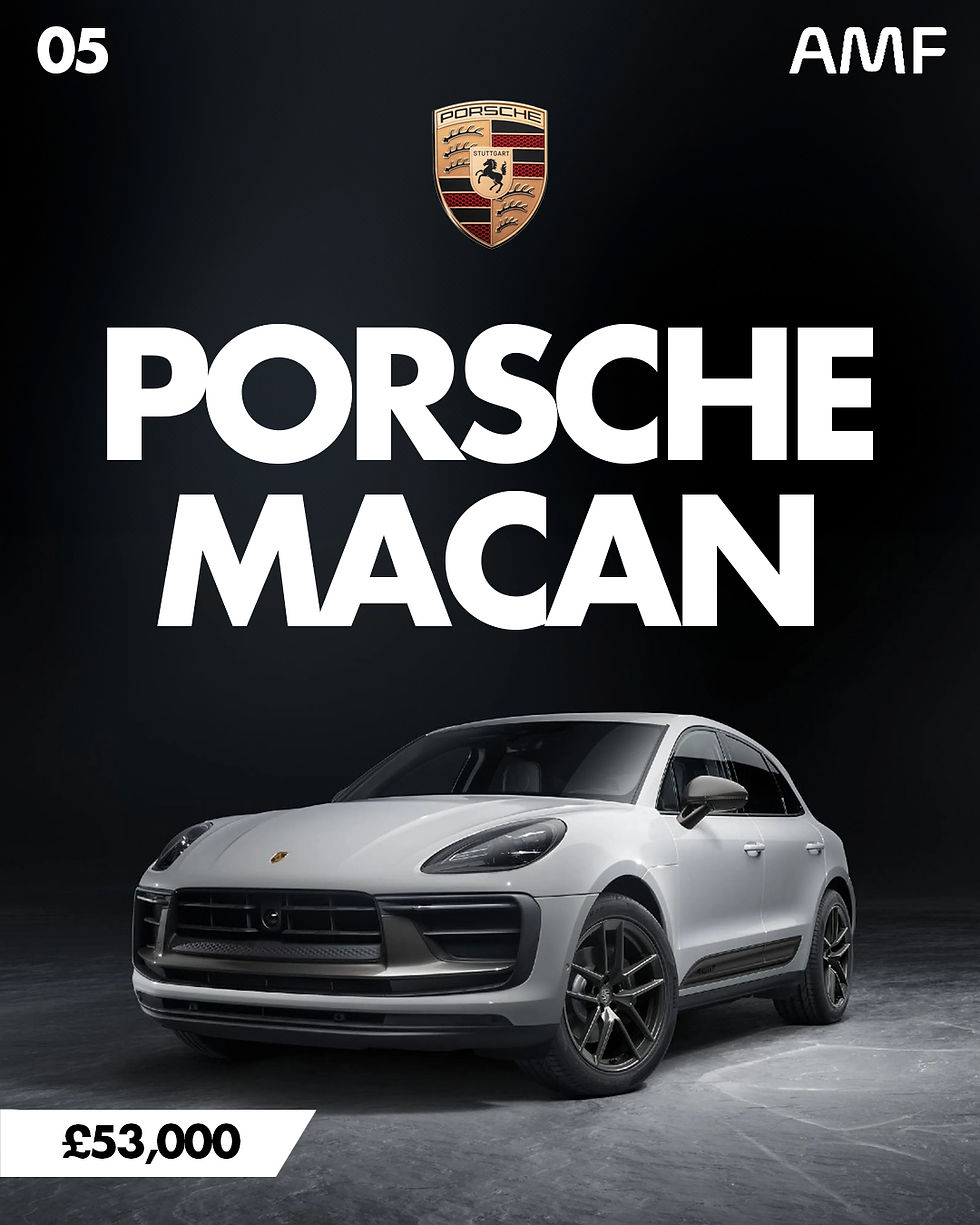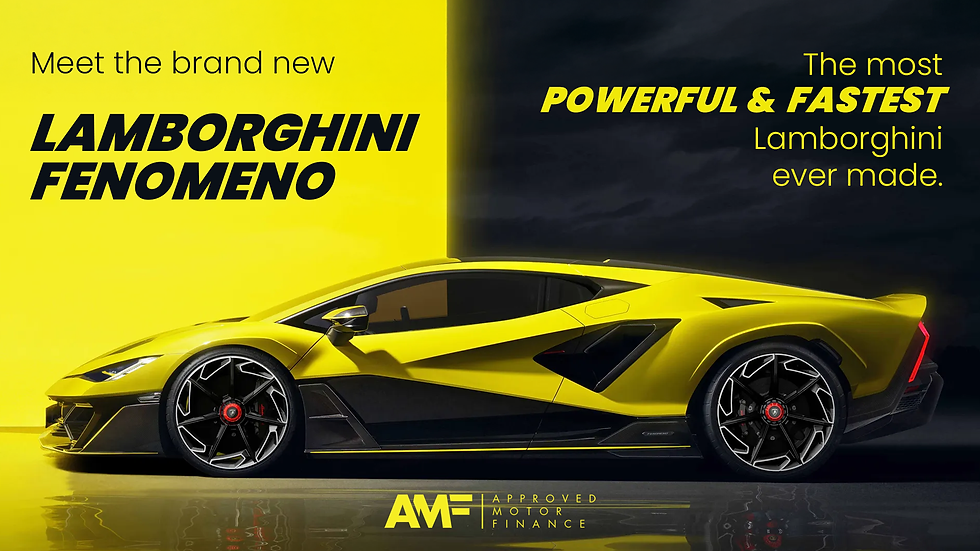BEST PERFORMANCE SUV's UNDER £170K - 2023
- Krish Appiah

- Oct 10, 2023
- 6 min read

Many driving enthusiasts may find it puzzling that high-performance SUVs exist, but even their toughest critics must acknowledge their crucial role in funding the production of the more traditionally beloved cars like the Cayenne, Urus, and DBX. These SUVs, such as the Cayenne, Urus, and DBX, keep iconic models like the 911, Hurácan, and DB12 in production, and for this, we are appreciative.
Beneath their large and heavy bodies, manufacturers are increasingly determined to imbue these SUVs with genuine athleticism. This determination has led to the development of innovative technologies like active anti-roll bars and massive brake packages, which are now making their way into other sectors such as GTs and EVs, which are approaching SUVs in terms of size and weight. The outcome is that certain SUVs are now exhibiting remarkable finesse on the road, like Jaguar's F-Pace SVR, the Aston Martin DBX707, and the impressive Alfa Romeo Stelvio Quadrifoglio. These vehicles not only handle well for SUVs but also possess their distinct feel and character.
Undoubtedly, high-performance SUVs entail compromises, and enthusiasts would prefer such dedication to be channeled into more agreeable sports car categories. However, market demands prevail, and at present, it seems almost unwise for a high-performance manufacturer to overlook the financial opportunities that SUVs frequently offer.
1. Aston Martin DBX
It was just a matter of time before Aston Martin jumped on the SUV bandwagon, following the lead of Jaguar with the F-Pace and, more recently, Lamborghini with its highly successful Urus. Despite the company's recent challenges, its engineers have succeeded in creating what might be the performance SUV that truly lives up to its promise and having the highest price tag on this list, the DBX also packs the most power.
Now available in two models, the base DBX and the DBX707, both offer distinct experiences. Both are powered by Mercedes-AMG's 4-liter hot-V twin-turbocharged V8 engine. The standard DBX generates 542bhp and 516lb ft of torque, delivering power to all four wheels through a nine-speed torque-converter automatic gearbox. This translates to a 4.5-second 0-62mph time and a top speed of 181mph.
The DBX707 takes things further with a specially tuned version of the same AMG V8. It incorporates significant upgrades, including new ball bearing turbos, a completely redesigned exhaust system, and a substantial overhaul of the engine mapping from valvetrain to fuel system. It produces an impressive 697bhp and 663llb ft of torque, channeled through AMG's nine-speed auto with a wet clutch and a shorter final drive. The 707 achieves a remarkable 0-62mph time of 3.3 seconds and boasts a top speed of 193mph, made possible by its standard carbon-ceramic brakes.
While straight-line performance figures are eye-catching, Aston focused its efforts elsewhere. Both DBX models offer dynamic abilities that set them apart from their competitors. The platform was meticulously developed from the ground up to extract maximum performance. The DBX delivers a smooth, refined GT-like feel, but when pushed, it tightens up brilliantly, showcasing exceptional handling.
2. Alfa Romeo Stelvio Quadrifoglio

We have a deep admiration for the Giulia Quadrifoglio, but standing right alongside this exceptional sedan is its Stelvio counterpart, which comes remarkably close in brilliance. Unlike most options in its category, the Stelvio stands out due to its relatively lightweight build, its raw edges, and a dominant character rarely found in this class.
The recently facelifted Stelvio Quadrifoglio shares the same robust 513bhp 2.9-liter twin-turbo V6 engine as its sedan counterpart, enabling it to achieve a 0-62mph time in less than four seconds. This V6 engine is paired with the familiar eight-speed automatic transmission, reconfigured for SUV use, and coupled with Alfa's Q4 all-wheel-drive system. It's this all-wheel-drive system that gives the Stelvio a unique feel compared to the sedan, sacrificing a bit of its ultimate agility and precision for enhanced traction.
In its automatic mode, the Stelvio Quadrifoglio behaves politely and swiftly above 3000rpm. However, to experience the full power of the V6 with a sharper throttle response and reduced shift times, you'll need to engage Dynamic or Race mode.
Beyond its powertrain, the Stelvio Quadrifoglio boasts an incredibly entertaining chassis, offering the same responsive steering you find in the Giulia. When combined with powerful brakes and excellent body control, it surprises with its engaging handling at high speeds. Although we haven't had the chance to test the updated version yet, it's expected to deliver more of the same thrilling performance – and that's undoubtedly a very positive aspect.
3. Porsche Cayenne
This SUV marked the beginning of a new era in sporty utility vehicles. When Porsche initially announced their decision to adorn their iconic emblem on a vehicle that deviated from the classic low-slung sports car, enthusiasts were in an uproar. Porsche fans were furious, considering it an abomination that shouldn't have been allowed.
However, when the first-generation Cayenne made its debut, and after the initial shock of brand dilution and unappealing aesthetics subsided, it became apparent that Porsche's chassis engineers had worked wonders on the Cayenne. It not only became a bestseller but also played a significant role in popularizing premium SUVs, especially the sporty segment of the market.
Despite the emergence of more luxurious competitors from renowned supercar manufacturers, the Cayenne remains one of the most enjoyable SUVs to drive. Currently, the most potent Cayenne available is the 468bhp S version, with GTS and Turbo S E-Hybrid models rumored to be introduced later. The incredibly capable Turbo GT variant, although no longer available in Europe, stood out as the most engaging of them all.
Even the lower-tier Cayenne models handle corners at unexpectedly high speeds while maintaining a sense of driver engagement and finesse, without compromising the practicality and solid construction that defines the Cayenne. A recent facelift introduced updated suspension, technology, and styling. Although we haven't had the opportunity to test it on UK roads yet, the new model is expected to enhance the Cayenne's core strengths.
4. Jaguar F-Pace SVR
Jaguar’s F-Pace SUV stands as a commendable effort from the British automaker, presenting a stylish family car that falls between the dimensions and price range of BMW’s X3 and X5 models. While the standard variants are respectable, our particular admiration is reserved for the SVR version, which happens to be the sole four-door Jaguar employing its supercharged V8 engine, coupled with the inherent charisma it brings.
Despite its association with Land Rover, the F-Pace doesn’t share much with its more off-road-oriented counterparts, except for the Range Rover Velar, which borrowed Jaguar’s underpinnings instead. The F-Pace's foundation is rooted in the XE and XF saloons, granting it exceptional road manners that defy its size, exuding a surprising sense of fun, poise, and composure.
Jaguar Land Rover’s 5-liter supercharged V8 engine delivers 542bhp and 516lb ft of torque, enabling a swift 0-62mph time of 4.0 seconds and reaching a top speed of 178mph. Yet, beyond the impressive performance figures, it’s the engine’s inherent character that truly captivates. It operates with an effortless ease, emitting a calming rumble under its vented bonnet, distinct from the more frenzied nature of some of its smaller turbocharged competitors.
Remarkably, the F-Pace handles exceptionally well for a vehicle of its size, owing much of its agility to its sturdy aluminum construction. It maintains a flat and stable posture in corners, aided by its rear-biased four-wheel-drive system that engages seamlessly, allowing drivers to explore its remarkable balance and composure even at the limits of its capabilities.
5. Porsche Macan
A high-performing SUV typically appears to challenge the laws of physics, and the Porsche Macan is a prime example of this phenomenon. Despite its increased weight and ride height, it delivers excitement comparable to that of a hot hatchback, albeit in a more spacious and practical package.
As expected, the top-tier Macan GTS leads the pack in terms of capability, boasting more power and a finely tuned chassis compared to the S, new T, and base four-cylinder models. In GTS guise, it harnesses 434bhp from its 2.9-liter twin-turbocharged V6 engine, a powerplant similar to the one found in Audi's RS4 and RS5 models.
While the GTS comes equipped with additional features, various chassis adjustments set it apart from the rest. The suspension is lowered, adaptive dampers are fine-tuned, and the brakes are upgraded to effectively bring its 1960kg weight to a halt. It accelerates from 0 to 62mph in an impressive 4.3 seconds (with the Sport Chrono Package fitted) and reaches a top speed of 169mph.
Most notably, the Macan demonstrates exceptional handling abilities. Its grip is incredibly tenacious, and its body control surpasses that of many hot hatchbacks. When pushed to its limits, it appears to defy the laws of physics rather aggressively instead of delicately navigating around them, yet it performs remarkably well. Even during everyday driving, it maintains acceptable road manners, making it a versatile and impressive vehicle overall.
Are you in the market for a brand new car? That reality may be closer than you think! Contact our specialist motor finance broker team at Approved Finance to explore your finance options for your dream car. Krish Appiah and Jessica Peaks are here to assist you. Call 01908 429888 or email info@approved-finance.co.uk.
For any guidance, please refer to our buyers guides found here.






